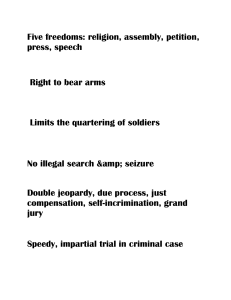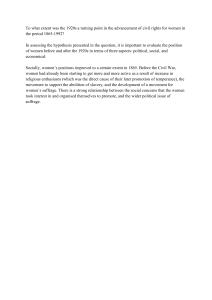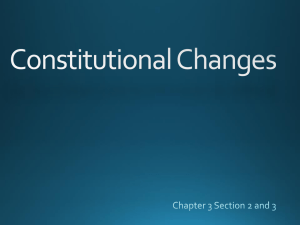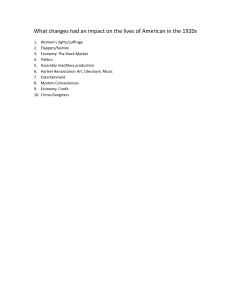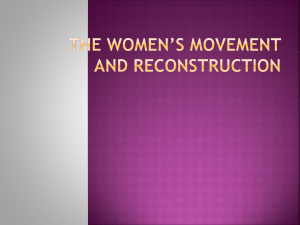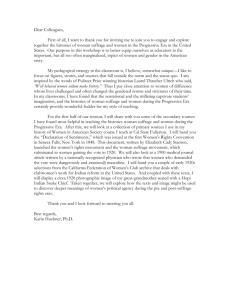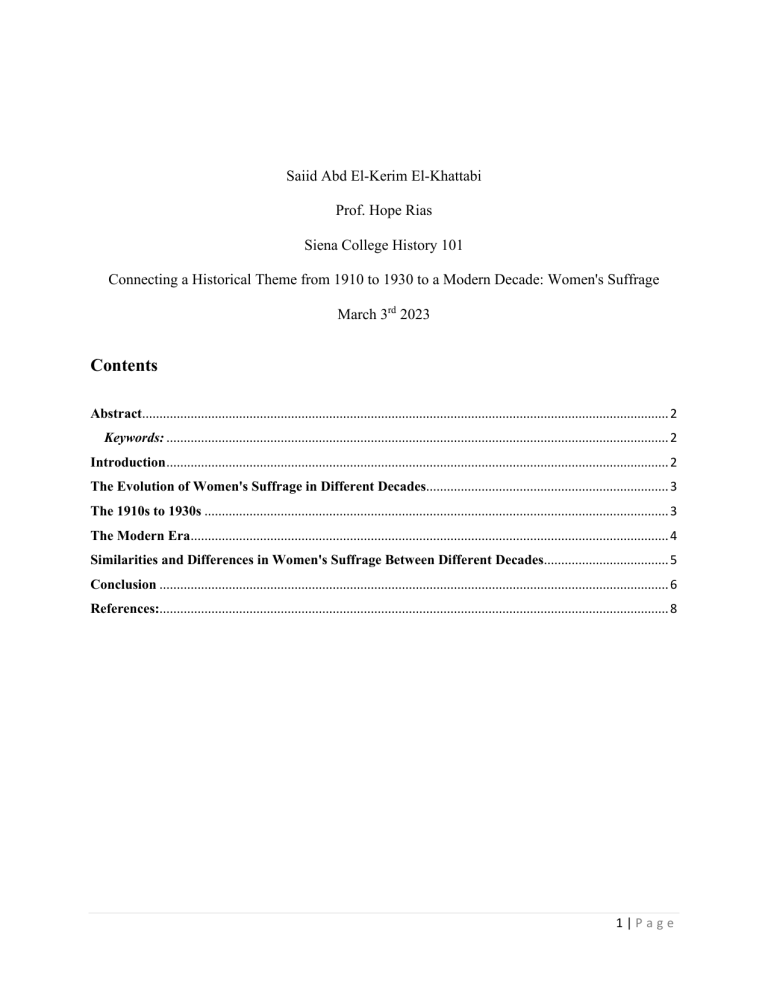
Saiid Abd El-Kerim El-Khattabi Prof. Hope Rias Siena College History 101 Connecting a Historical Theme from 1910 to 1930 to a Modern Decade: Women's Suffrage March 3rd 2023 Contents Abstract........................................................................................................................................................ 2 Keywords: ................................................................................................................................................. 2 Introduction ................................................................................................................................................. 2 The Evolution of Women's Suffrage in Different Decades...................................................................... 3 The 1910s to 1930s ...................................................................................................................................... 3 The Modern Era.......................................................................................................................................... 4 Similarities and Differences in Women's Suffrage Between Different Decades.................................... 5 Conclusion ................................................................................................................................................... 6 References:................................................................................................................................................... 8 1|Page Saiid Abd El-Kerim El-Khattabi Prof. Hope Rias Siena College History 101 Connecting a Historical Theme from 1910 to 1930 to a Modern Decade: Women's Suffrage March 3rd 2023 Abstract The purpose of this paper is to relate a historical theme from the 1910s to the present. For this purpose, I have decided to examine the evolution of women's suffrage over the decades. I have discussed the conditions that contributed to the formation of this theme in the early 20th century as well as its effects on the modern era. The similarities and differences between the theme of women's suffrage in the 1910s to 1930s and the present day have been explored. This paper's argument is supported by scholarly journals, books, and newspapers, among other sources. Keywords: Women's Suffrage, Historical Theme, Modern Decade Introduction There are several events, movements, and themes in history that have had a significant impact on society. Many of these concepts have evolved and shaped our contemporary world. The purpose of this article is to investigate how one of the most significant historical subjects, women's suffrage, has affected different eras and how it has progressed in the twenty-first century. The theme of women's suffrage developed around the beginning of the 20th century, and its goal was to guarantee the right to vote and equal political representation for women. The fight for women's suffrage was prolonged and difficult, spanning several decades. Women's suffrage movement did not acquire momentum until the 1910s and 1930s, when several movements and protests were established to ensure women's right to vote. In this paper, I will analyze the Page | 2 Saiid Abd El-Kerim El-Khattabi Prof. Hope Rias Siena College History 101 Connecting a Historical Theme from 1910 to 1930 to a Modern Decade: Women's Suffrage March 3rd 2023 conditions that contributed to the creation of women's suffrage in the early 20th century, as well as the effect it has had on contemporary society. The Evolution of Women's Suffrage in Different Decades The 1910s to 1930s During the 1910s and 1930s, the women's suffrage movement gained momentum. For decades, women fought for the right to vote and equal representation, but it wasn't until the 1910s that the cause acquired national prominence. Several factors contributed to the establishment of women's right in this era. In the early 20th century, society did not view women as equal to men. They lacked the right to vote and were prohibited from certain professions. Similarly, women were paid less than men for performing the same work. In reaction to these disparities, the women's suffrage movement emerged. The women's suffrage movement was a collaboration of organizations and individuals who fought for the right of women to vote. Founded in 1890, the National American Woman Suffrage Association (NAWSA) was the most important organization. Susan B. Anthony and Elizabeth Cady Stanton, two of the most notable women's rights advocates of their time, led the NAWSA. The NAWSA coordinated numerous campaigns and demonstrations to secure the right to vote for women. The Suffrage Parade of 1913, which was held in Washington, D.C., was one of Page | 3 Saiid Abd El-Kerim El-Khattabi Prof. Hope Rias Siena College History 101 Connecting a Historical Theme from 1910 to 1930 to a Modern Decade: Women's Suffrage March 3rd 2023 the most notable protests. It was the first time such a big protest had been organized to promote women's rights, and thousands of women joined in the procession. The women's suffrage campaign met strong opposition from politicians, religious leaders, and business owners, among others. Many believed women lacked the mental capacity to vote, and they feared women would vote against their interests. Furthermore, the suffrage campaign was attacked for being too radical and for upsetting society's conventional gender norms. The women's suffrage campaign continued to gain pace despite opposition. The 19th Amendment to the United States Constitution, which guaranteed women the right to vote, was ratified in 1919. The ratification of the 19th Amendment was a major triumph for the women's suffrage campaign, and it prepared the way for further advances in women's rights. The Modern Era Passage of the 19th Amendment was a major triumph for women's right, but it did not eliminate all of the challenges women faced in society. In various areas, including school, work, and healthcare, prejudice and inequality against women persisted. In the latter half of the 20th century, increased attention was paid to women's rights. Women's rights have seen substantial developments in the modern age, including the establishment of organizations and laws aimed at promoting gender equality. One of the most notable shifts has been the rise in women's political participation. In 2021, Kamala Harris became the first woman and person of color to serve as the United States' Vice President. Page | 4 Saiid Abd El-Kerim El-Khattabi Prof. Hope Rias Siena College History 101 Connecting a Historical Theme from 1910 to 1930 to a Modern Decade: Women's Suffrage March 3rd 2023 Additionally, women have made considerable achievements in the workforce, with more women joining previously male-dominated fields. Yet, the gender wage gap persists, and women continue to confront job growth obstacles. In 2017, the #MeToo campaign drew attention to the subject of sexual harassment and assault. The objective of the movement was to bring attention to the frequency of sexual harassment and assault in different industries, including entertainment, politics, schools, and business. Despite the fact that women's rights have made considerable strides in the modern era, there is still more to be done. In various fields, including school, employment, and healthcare, women continue to endure prejudice and injustice. The COVID-19 pandemic has also highlighted the disproportionate impact of the pandemic on women, with women being more likely to lose their jobs and take on increased caregiving responsibilities. Similarities and Differences in Women's Suffrage Between Different Decades There are a number of similarities and differences between women's suffrage in the 1910s and 1930s and the present day. The ongoing push for gender equality is one of the most striking similarities. Although women have made great strides in the modern era, there is still a long way to go before achieving complete gender equality. Both eras have struggled against opposition to women's rights and traditional gender norms. Page | 5 Saiid Abd El-Kerim El-Khattabi Prof. Hope Rias Siena College History 101 Connecting a Historical Theme from 1910 to 1930 to a Modern Decade: Women's Suffrage March 3rd 2023 The strategies employed to win women's rights is one of the key contrasts between the two eras. During the 1910s to the 1930s, protests and campaigns were the most prevalent means of securing women's voting rights. In the current period, legal action and governmental reforms have taken precedence. Title IX and the Equal Pay Act of 1963 have played an important role in fostering gender equality. The scope of women's rights is an additional noteworthy difference. During the 1910s to the 1930s, gaining the right to vote for women was a priority. The campaign for women's rights has evolved to include reproductive rights, equal pay, and the fight against sexual harassment and assault in the modern era. Conclusion The emergence of women's suffrage as a key historical subject in the early 20th century was a defining moment in time. The decades-long struggle for women's rights culminated in 1919 with the adoption of the 19th Amendment. While women have made great strides in the contemporary age, there is still a great deal of work to be done to attain complete gender equality. Women's rights have seen considerable developments in the modern age, including increased participation in politics and the workforce. Yet, women continue to confront prejudice and inequality in a variety of fields, including education, employment, and healthcare. The struggle for women's rights now encompasses reproductive rights, equitable pay, and the fight against sexual harassment and assault. Page | 6 Saiid Abd El-Kerim El-Khattabi Prof. Hope Rias Siena College History 101 Connecting a Historical Theme from 1910 to 1930 to a Modern Decade: Women's Suffrage March 3rd 2023 There are a number of parallels and distinctions between women's suffrage in the 1910s and 1930s and the present day. Both eras have struggled against opposition to women's rights and traditional gender norms. Yet, the strategies employed to guarantee women's rights and the range of women's rights have evolved. The struggle for women's suffrage is a reminder of the strength of collective action and the significance of standing up for what is right. It is essential to continue the battle for gender equality and ensure that women have the same rights and opportunities as men. By exploring historical themes and their ties to contemporary times, we can acquire a better understanding of the progress gained and the work that remains. Page | 7 Saiid Abd El-Kerim El-Khattabi Prof. Hope Rias Siena College History 101 Connecting a Historical Theme from 1910 to 1930 to a Modern Decade: Women's Suffrage March 3rd 2023 References: - Buchanan, R. (2016). The suffragette movement: women's votes, equal votes. Oxford University Press. - Eisenberg, B. (2018). Women's suffrage. In Salem Press Encyclopedia. - Friedan, B. (1963). The feminine mystique. W.W. Norton & Company. - History.com Editors. (2020). Women's suffrage. History.com. https://www.history.com/topics/womens-history/the-fight-for-womens-suffrage - National Women's History Museum. (n.d.). Women's suffrage. Retrieved from https://www.womenshistory.org/resources/general/womens-suffrage - United States Census Bureau. (2021). Facts for features: Women's history month: March 2021. Retrieved from https://www.census.gov/newsroom/facts-forfeatures/2021/womens-history-month.html Page | 8
